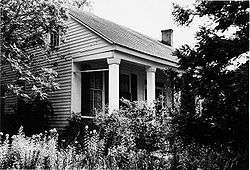Henry D. Clayton House
The Henry D. Clayton House is a historic plantation house in Clayton, Alabama, most notable as the birthplace and childhood home of Henry De Lamar Clayton, Jr. (1857-1929), a legislator and judge. Clayton came to prominence while serving in the United States Congress as the author of the Clayton Antitrust Act of 1914. This act prohibited particular types of conduct that were deemed to not be in the best interest of a competitive market. He was appointed as a Federal District Judge in 1914, where he became recognized as an advocate for judicial reform.[2] The house was built by his father, Confederate General Henry DeLamar Clayton, Sr. It was declared a National Historic Landmark on December 8, 1976.[2][3]
Henry D. Clayton House | |
 Henry De Lamar Clayton House, 1975 | |
  | |
| Location | SR 30, Clayton, Alabama |
|---|---|
| Coordinates | 31°51′56.2″N 85°27′08.5″W |
| Area | c. 51 acres (21 ha) |
| Built | 1850 |
| Architect | Henry D. Clayton, Sr. |
| NRHP reference No. | 76002259 |
| Significant dates | |
| Added to NRHP | December 8, 1976[1] |
| Designated NHL | December 8, 1976[2] |
Description and history
The Henry D. Clayton House is located about 1 mile (1.6 km) from Clayton on a remnant of the former 1,000-acre (400 ha) Clayton Plantation. It is accessed via the original plantation drive, extending south from SR 30 at Clayton Street. The house is a 1-1/2 story wood frame structure, with a gabled roof and clapboarded exterior. The main roof extends beyond the north facade to shelter a porch with square supports. A shed-roof porch also extends across part of the house's rear, where it joins with the kitchen ell. Outbuildings in the plantation complex include a smokehouse, carriage barn, and a small cottage used by Henry Clayton Jr. as his office.[3]
The house was built about 1850 by Henry DeLamar Clayton, Sr., who served in the American Civil War as a general in the Confederate Army. It was the birthplace and childhood home of his son Henry Clayton Jr. The younger Clayton studied law at the University of Alabama, and embarked on a political career in the Democratic Party in 1880. In 1910, as head of the House Judiciary Committee, he successfully prosecuted the impeachment of Robert W. Archbald, a Commerce Court judge accused of profiting from his position. His best-known accomplishment was passage of the Clayton Antitrust Act, a significant amendment to the Sherman Antitrust Act.[3]
See also
| Wikimedia Commons has media related to Henry D. Clayton House. |
References
- "National Register Information System". National Register of Historic Places. National Park Service. January 23, 2007.
- "Henry D. Clayton House". National Historic Landmark summary listing. National Park Service. Archived from the original on 2009-03-01. Retrieved 2007-10-20.
- Dorothy K. Dickens; Ralph Christian; George R. Adams (February 1976). "National Register of Historic Places Inventory-Nomination: Henry D. Clayton House / Clayton Plantation" (pdf). National Park Service. Cite journal requires
|journal=(help) and Accompanying 4 photos, exterior, from 1975. (3.10 MB)